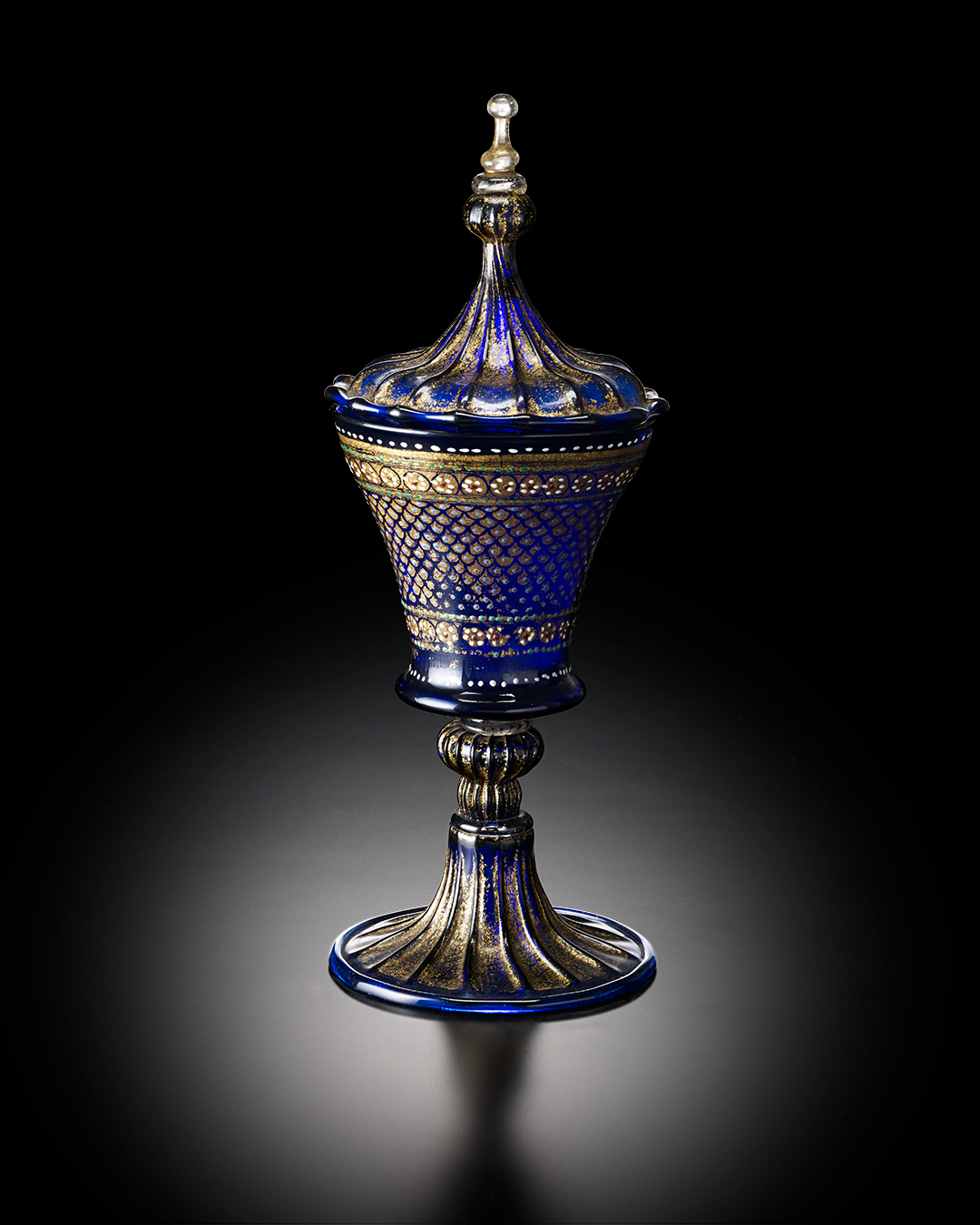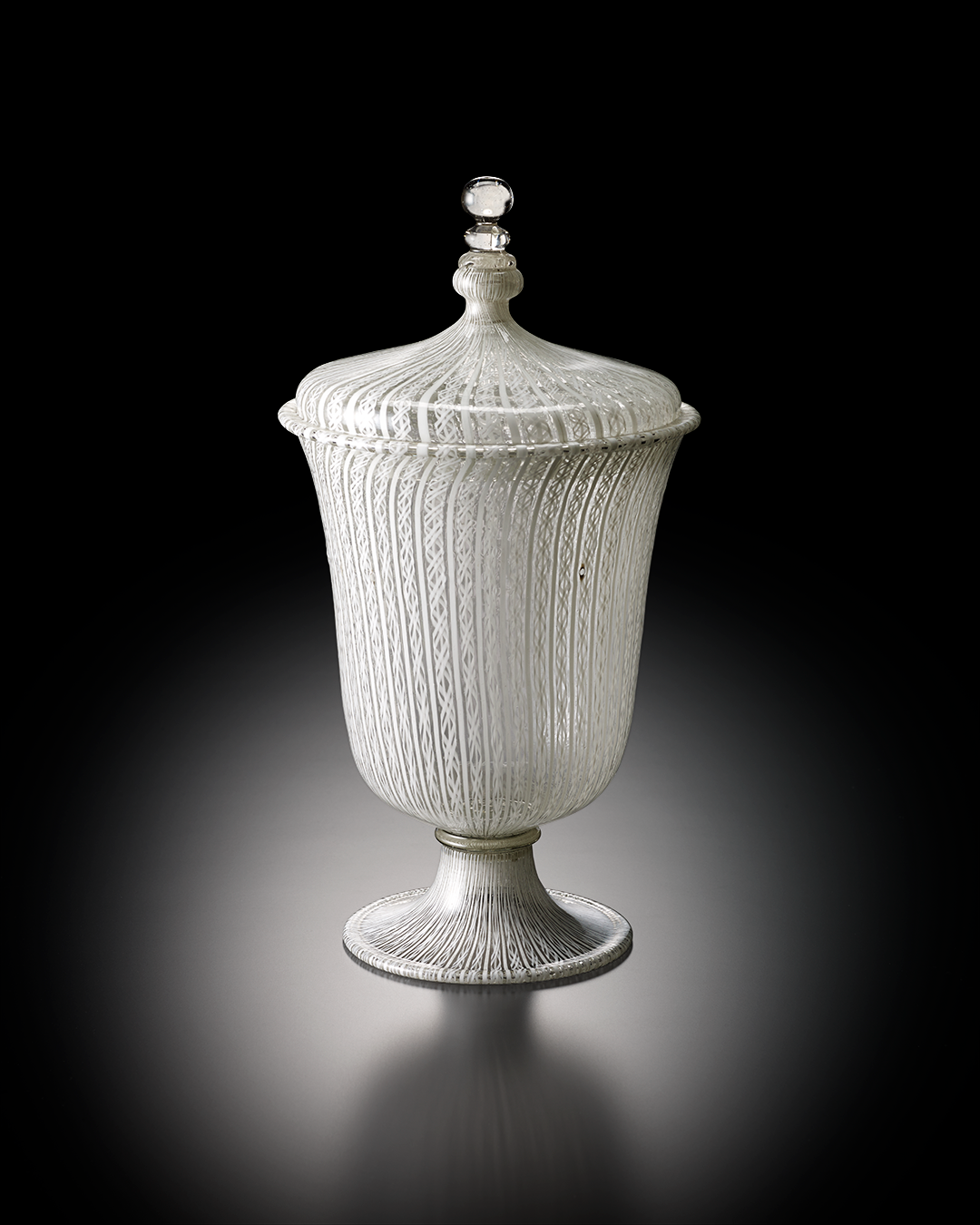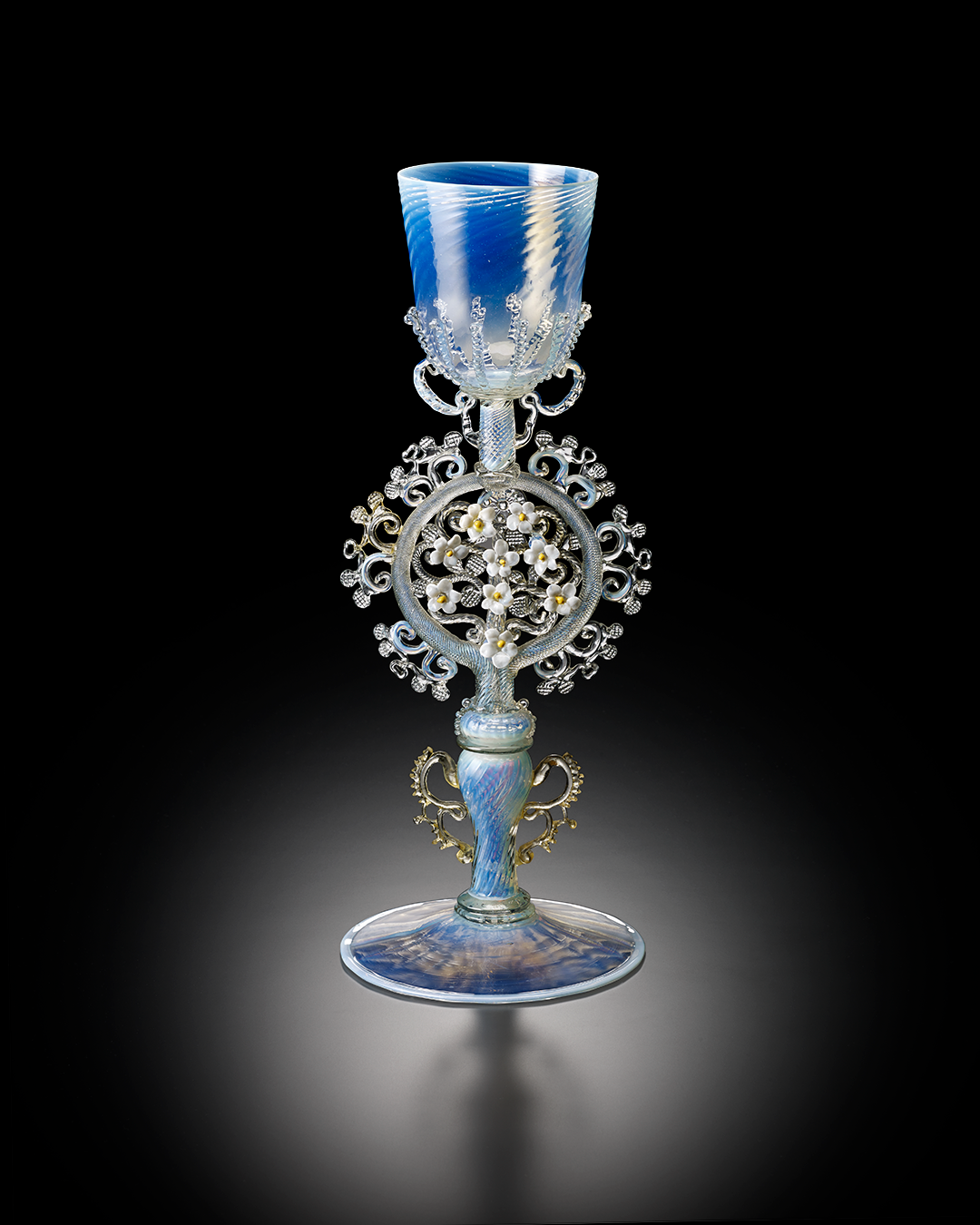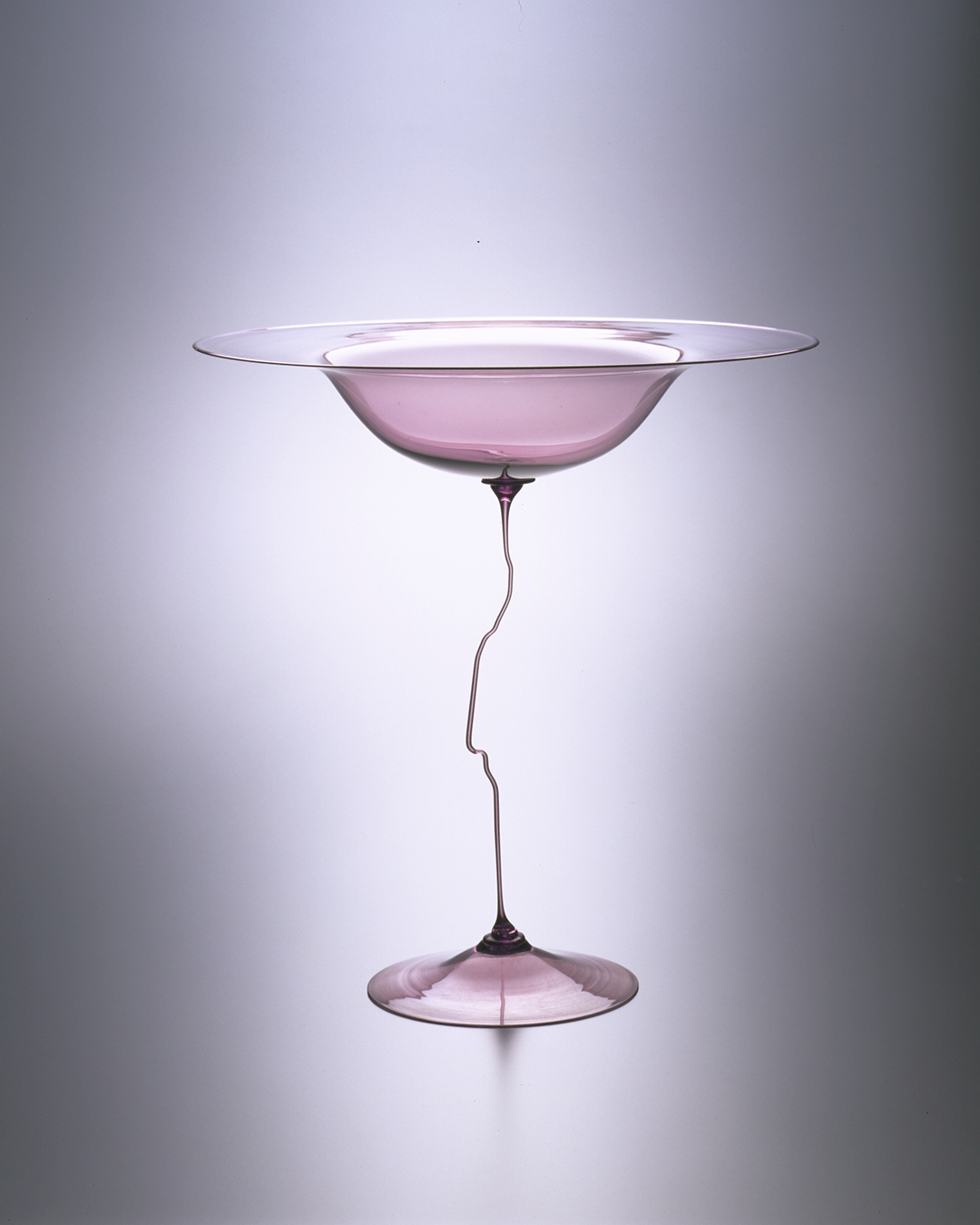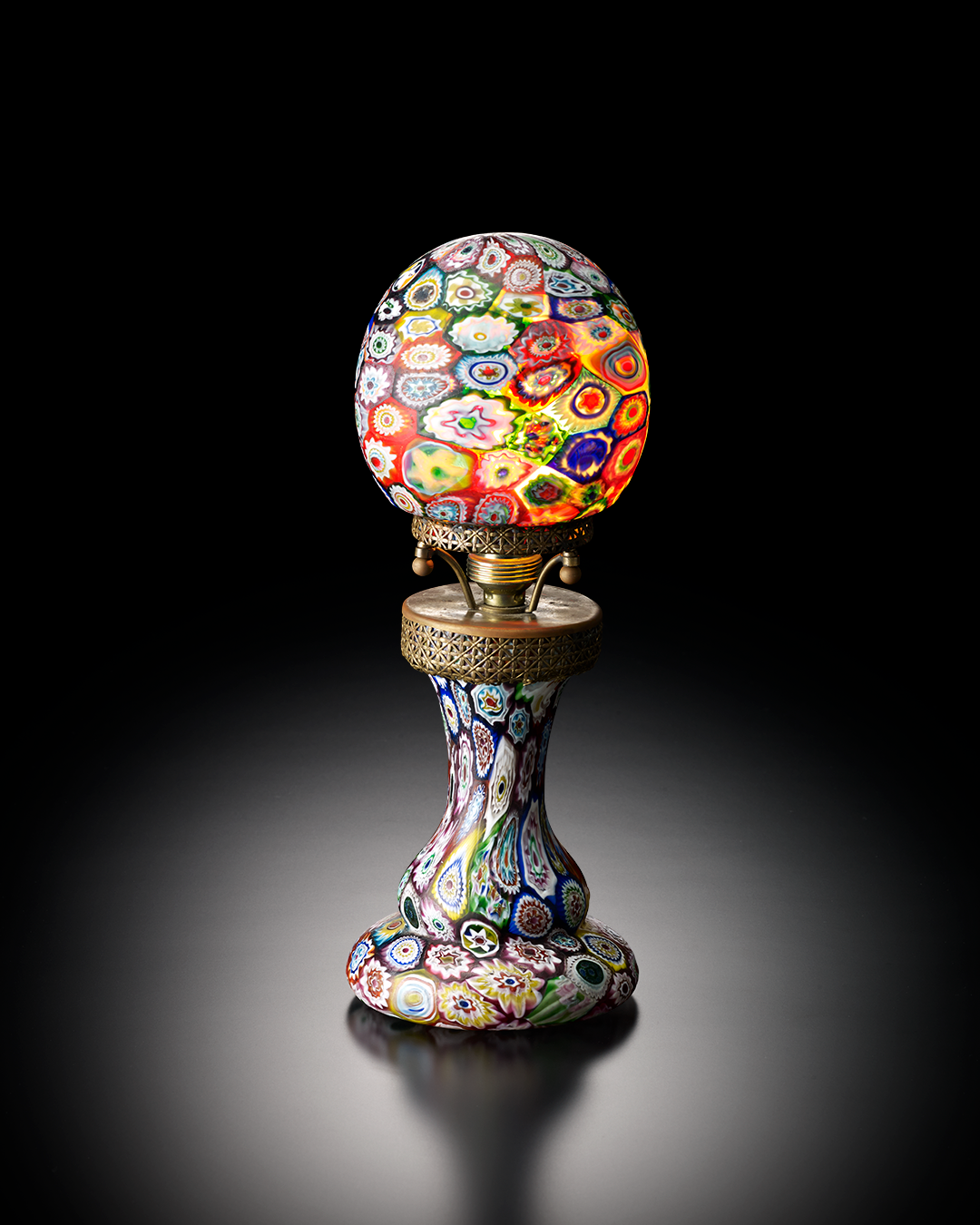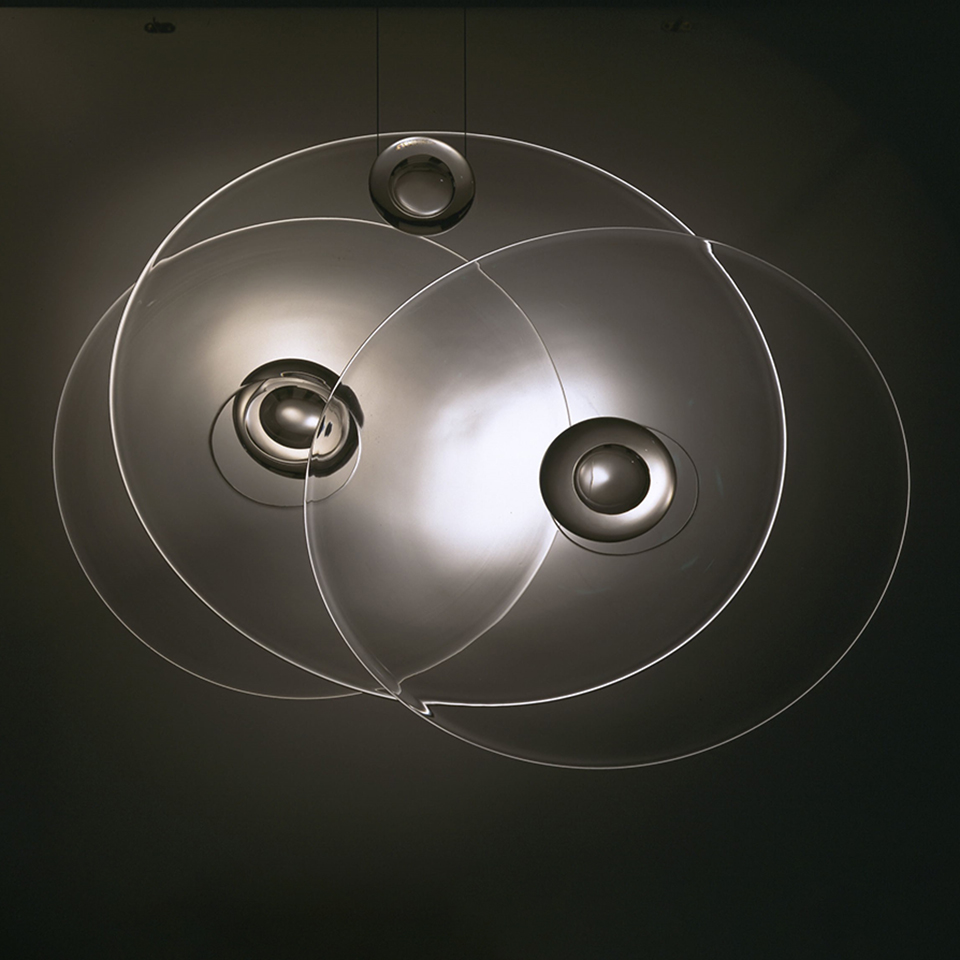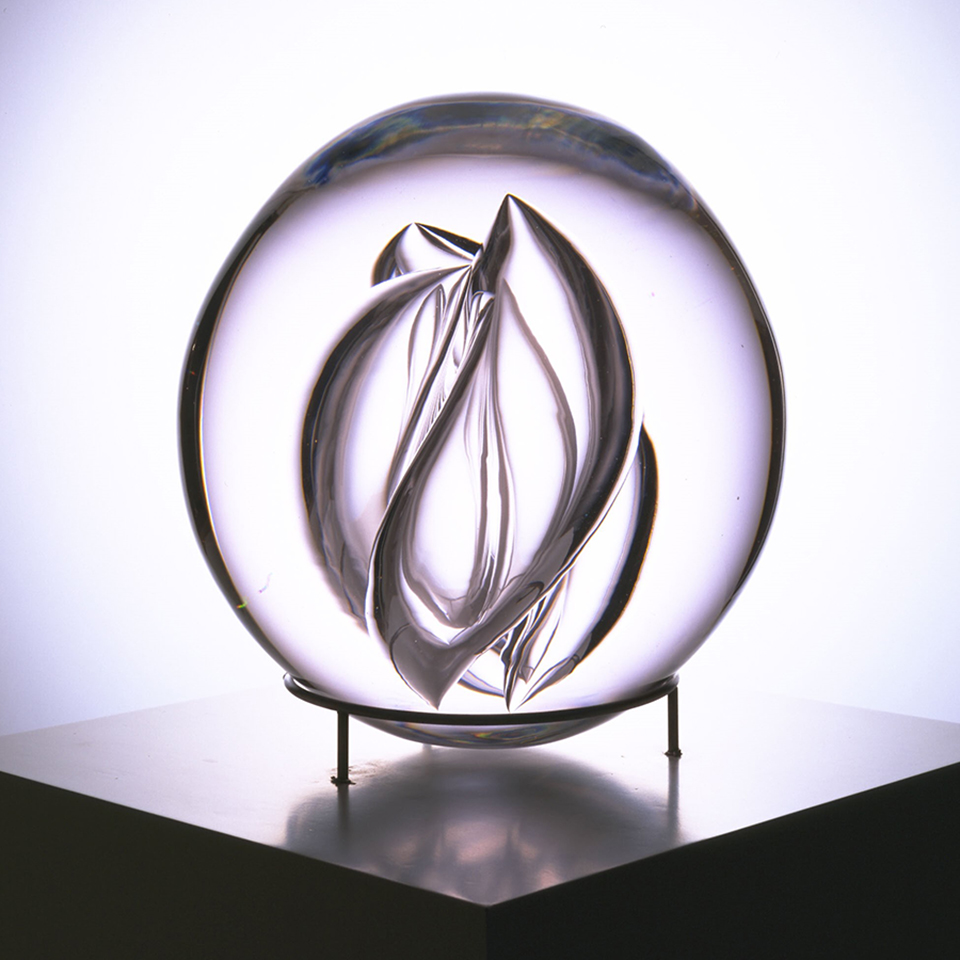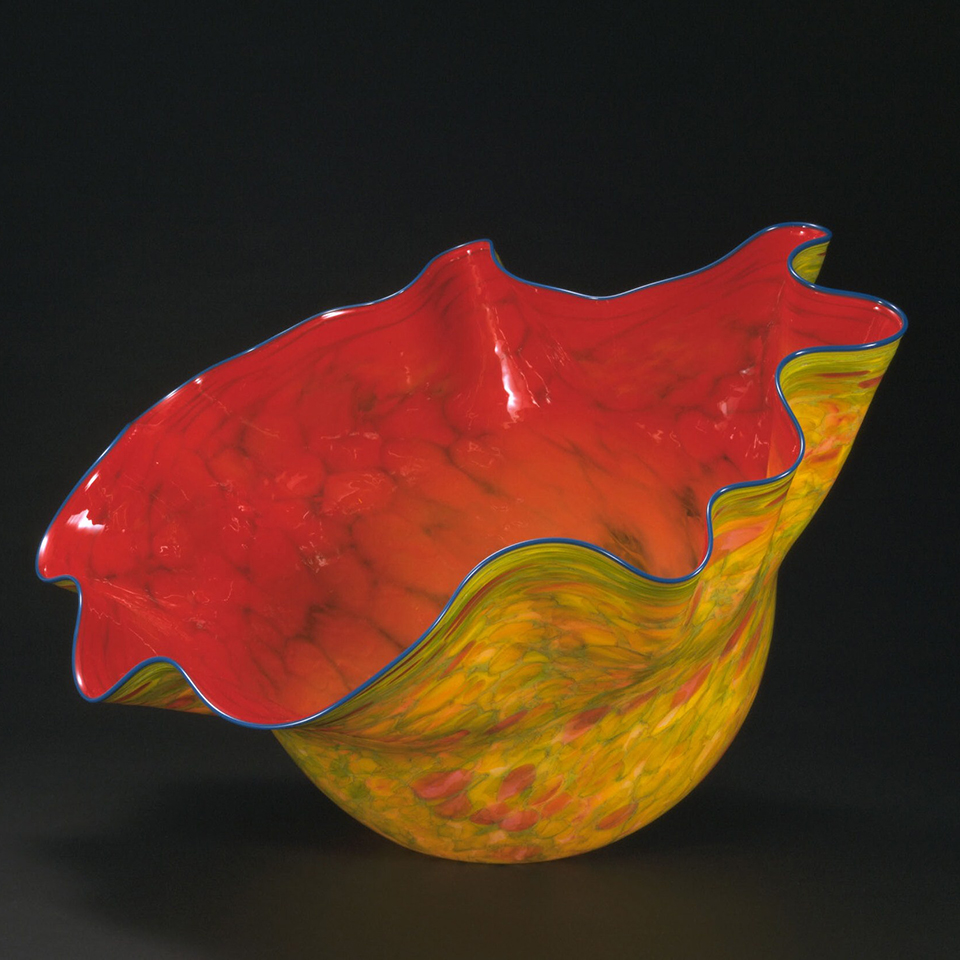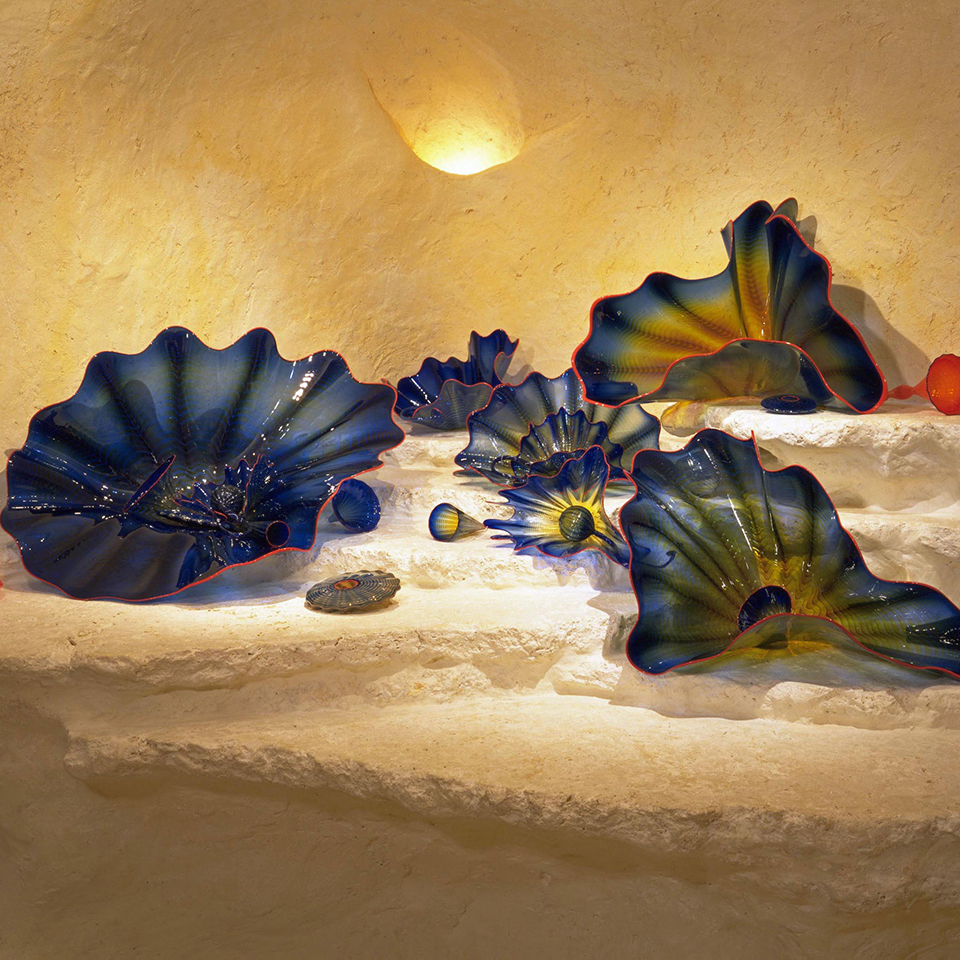展现了卓越技艺的美学极致
以 15~16 世纪黄金时期的威尼斯玻璃为核心,展览还包括公元前的古代玻璃、19 世纪 Salviati 工作室等复兴时期的装饰玻璃,以及 20 世纪出现的玻璃艺术品。从约 1000 件收藏作品中,根据展览主题精选出的大约 100 件作品,您可以随时观赏。
展现了卓越技艺的美学极致
以 15~16 世纪黄金时期的威尼斯玻璃为核心,展览还包括公元前的古代玻璃、19 世纪 Salviati 工作室等复兴时期的装饰玻璃,以及 20 世纪出现的玻璃艺术品。从约 1000 件收藏作品中,根据展览主题精选出的大约 100 件作品,您可以随时观赏。
展现了卓越技艺的美学极致
以 15~16 世纪黄金时期的威尼斯玻璃为核心,展览还包括公元前的古代玻璃、19 世纪 Salviati 工作室等复兴时期的装饰玻璃,以及 20 世纪出现的玻璃艺术品。从约 1000 件收藏作品中,根据展览主题精选出的大约 100 件作品,您可以随时观赏。
展现了卓越技艺的美学极致
以 15~16 世纪黄金时期的威尼斯玻璃为核心,展览还包括公元前的古代玻璃、19 世纪 Salviati 工作室等复兴时期的装饰玻璃,以及 20 世纪出现的玻璃艺术品。从约 1000 件收藏作品中,根据展览主题精选出的大约 100 件作品,您可以随时观赏。
History of Venetian glass
Since the time of ancient Rome to today, Venetian glass has been a major part of Venetian history and has set the destiny of people on Murano.
The Roman Empire
The history of Venetian glass started with Roman glass in the Roman Empire (1st century BC to 5th century AD). Glassblowing was a revolutionary invention already used by many glass factories throughout the Italian peninsula. Glassmaking techniques and glassware spread throughout the world. However, with the fall of the Roman Empire in 476, the glass industry quickly declined.
Rialto
In the 8th century, the central part of the Venetian Republic moved to Rialto, where many churches and cathedrals were built all over the island. Many glass factories also moved to Rialto.
Booming glass industry
In 1078, the reconstruction of St. Mark’s Basilica started. Glass mosaics were installed on all the walls. According to historical documents, 29 glassworkers were fined for violating glassmaking customs and regulations. This indicates a booming glass industry.
Governmental protection and control
The 13th century saw major involvement of the government in the Venetian glass industry. It formed the Venetian Glass Guild in 1268, concluded contracts with Antioch (Syria’s largest producer of glass) to import raw glass materials, directly controlled firewood to streamline fuel management, and banned operations in summer.
Then in 1291, the Venetian government, seeking to protect the Venetian glass industry, enacted a law to require all glass makers, assistants, and their families to move to Murano island. Any escapees would be punished with death. The development of Venetian glass then centered on Murano.
The heyday of Venetian glass
In the 13th and 14th centuries, Venetian glass developed under the strong influence of Byzantine and Islamic aesthetics, especially in enameling techniques and designs. In the 15th century, it matured further with the backdrop of the Italian Renaissance.
In the latter half of the 16th century, Venetian glass reached its zenith with many groundbreaking techniques for finer and more splendid designs like diamond-point engraving, lace glass (filigrana), crystal glass, crackled glass, and marbled glass. Glassware in diverse forms for diverse functions were produced.
Hard times
In the 18th century, a new industrialism emerged in Europe when countries imposed high tariffs on imported goods to protect domestic industries. As a result, glass-producing countries suffered a drastic drop in exports and many glass factories went bankrupt. Murano was no exception.
To overcome these hard times, Murano glassmakers did whatever they could to survive by producing finer mosaics, church interiors and ornaments, and exporting to Africa and Southeast Asia. However, the dissolution of the Venetian Republic in 1797 marked the end of governmental patronage of the glass industry. Ten years later in 1806, Murano’s venerable glassmakers’ guild was forced to disband after 500 years.
The modernization of Venetian glass
While Murano’s glass industry faced stagnation, modernization kicked off a new era in the 19th century. Many museums and archives were established as new platforms for industry and education. The new museums needed vintage artifacts to be exhibited. But there were not enough of them, so Murano’s master glassmakers created replicas of ancient glassware.
This was followed by their glass mosaic techniques with colored glass inimitable by any glassmaker in any other country. They restored old church murals and created a new sector for interior design glasswork. It was a new beginning after a period of hardship.
Murano also saw many new movements. They included the construction of modern factories, the loosening of the closed system, the establishment of educational institutions for apprentices, the construction of glass museums, and the organizing of exhibitions and research societies. Through the cooperation of pioneering leaders and traditional craftsmen, Venetian glass arose from a dark period to go forward on the path to modernization.
History of Venetian glass
Since the time of ancient Rome to today, Venetian glass has been a major part of Venetian history and has set the destiny of people on Murano.
The Roman Empire
The history of Venetian glass started with Roman glass in the Roman Empire (1st century BC to 5th century AD). Glassblowing was a revolutionary invention already used by many glass factories throughout the Italian peninsula. Glassmaking techniques and glassware spread throughout the world. However, with the fall of the Roman Empire in 476, the glass industry quickly declined.
Rialto
In the 8th century, the central part of the Venetian Republic moved to Rialto, where many churches and cathedrals were built all over the island. Many glass factories also moved to Rialto.
Booming glass industry
In 1078, the reconstruction of St. Mark’s Basilica started. Glass mosaics were installed on all the walls. According to historical documents, 29 glassworkers were fined for violating glassmaking customs and regulations. This indicates a booming glass industry.
Governmental protection and control
The 13th century saw major involvement of the government in the Venetian glass industry. It formed the Venetian Glass Guild in 1268, concluded contracts with Antioch (Syria’s largest producer of glass) to import raw glass materials, directly controlled firewood to streamline fuel management, and banned operations in summer.
Then in 1291, the Venetian government, seeking to protect the Venetian glass industry, enacted a law to require all glass makers, assistants, and their families to move to Murano island. Any escapees would be punished with death. The development of Venetian glass then centered on Murano.
The heyday of Venetian glass
In the 13th and 14th centuries, Venetian glass developed under the strong influence of Byzantine and Islamic aesthetics, especially in enameling techniques and designs. In the 15th century, it matured further with the backdrop of the Italian Renaissance.
In the latter half of the 16th century, Venetian glass reached its zenith with many groundbreaking techniques for finer and more splendid designs like diamond-point engraving, lace glass (filigrana), crystal glass, crackled glass, and marbled glass. Glassware in diverse forms for diverse functions were produced.
Hard times
In the 18th century, a new industrialism emerged in Europe when countries imposed high tariffs on imported goods to protect domestic industries. As a result, glass-producing countries suffered a drastic drop in exports and many glass factories went bankrupt. Murano was no exception.
To overcome these hard times, Murano glassmakers did whatever they could to survive by producing finer mosaics, church interiors and ornaments, and exporting to Africa and Southeast Asia. However, the dissolution of the Venetian Republic in 1797 marked the end of governmental patronage of the glass industry. Ten years later in 1806, Murano’s venerable glassmakers’ guild was forced to disband after 500 years.
The modernization of Venetian glass
While Murano’s glass industry faced stagnation, modernization kicked off a new era in the 19th century. Many museums and archives were established as new platforms for industry and education. The new museums needed vintage artifacts to be exhibited. But there were not enough of them, so Murano’s master glassmakers created replicas of ancient glassware.
This was followed by their glass mosaic techniques with colored glass inimitable by any glassmaker in any other country. They restored old church murals and created a new sector for interior design glasswork. It was a new beginning after a period of hardship.
Murano also saw many new movements. They included the construction of modern factories, the loosening of the closed system, the establishment of educational institutions for apprentices, the construction of glass museums, and the organizing of exhibitions and research societies. Through the cooperation of pioneering leaders and traditional craftsmen, Venetian glass arose from a dark period to go forward on the path to modernization.




技法
马赛克玻璃(千花玻璃)
这种技法最早在公元前 15 世纪的美索不达米亚地区制作的作品中出现,并在公元前 2 世纪到公元后 1 世纪的古罗马帝国得到发展。虽然后来一度衰退,但在 19 世纪由威尼斯的玻璃工匠复兴。制作马赛克玻璃的材料是各种图案的玻璃片,这些玻璃片是将多层玻璃覆盖在一起,将其拉长成玻璃棒后,再横向切割制成的。由于看起来像玻璃器皿上绽放的花朵,因此在意大利语中被称为千花(Millefiori)玻璃。
蕾丝玻璃
这是一种用透明玻璃和乳白色等彩色玻璃结合制成的细线,创造出类似蕾丝编织的图案的玻璃器皿的统称。虽然公元前 3 世纪以后的意大利和亚历山大的玻璃器皿中也存在类似的技法,但真正发展和精致化这种技术的是 16 世纪中期的威尼斯 玻璃工匠。这种精致细腻的蕾丝玻璃后来成为威尼斯玻璃的代名词。在意大利,蕾丝玻璃被称为 Filigrana,根据乳白色玻璃构成的图案不同,分为螺旋图案的 Retortoli、网格图案的 Reticello 和平行线状条纹的 阿·菲里 三种。
大理石玻璃
这种玻璃是将不同颜色的玻璃熔合混合后成型,表面呈现出大理石、玛瑙或其他天然宝石的图案。在 15 世纪后期的威尼斯发明,并在 16 至 17 世纪流行的大理石玻璃,其中包含银离子的玻璃在光照射下颜色会变红,因此被称为 Chalcedony(意大利语中的红玛瑙)。从 17 世纪后半到 18 世纪,还制作了在玻璃中嵌入金属或金属化合物晶体的砂金石玻璃作品。
技法
马赛克玻璃(千花玻璃)
这种技法最早在公元前 15 世纪的美索不达米亚地区制作的作品中出现,并在公元前 2 世纪到公元后 1 世纪的古罗马帝国得到发展。虽然后来一度衰退,但在 19 世纪由威尼斯的玻璃工匠复兴。制作马赛克玻璃的材料是各种图案的玻璃片,这些玻璃片是将多层玻璃覆盖在一起,将其拉长成玻璃棒后,再横向切割制成的。由于看起来像玻璃器皿上绽放的花朵,因此在意大利语中被称为千花(Millefiori)玻璃。
蕾丝玻璃
这是一种用透明玻璃和乳白色等彩色玻璃结合制成的细线,创造出类似蕾丝编织的图案的玻璃器皿的统称。虽然公元前 3 世纪以后的意大利和亚历山大的玻璃器皿中也存在类似的技法,但真正发展和精致化这种技术的是 16 世纪中期的威尼斯 玻璃工匠。这种精致细腻的蕾丝玻璃后来成为威尼斯玻璃的代名词。在意大利,蕾丝玻璃被称为 Filigrana,根据乳白色玻璃构成的图案不同,分为螺旋图案的 Retortoli、网格图案的 Reticello 和平行线状条纹的 阿·菲里 三种。
大理石玻璃
这种玻璃是将不同颜色的玻璃熔合混合后成型,表面呈现出大理石、玛瑙或其他天然宝石的图案。在 15 世纪后期的威尼斯发明,并在 16 至 17 世纪流行的大理石玻璃,其中包含银离子的玻璃在光照射下颜色会变红,因此被称为 Chalcedony(意大利语中的红玛瑙)。从 17 世纪后半到 18 世纪,还制作了在玻璃中嵌入金属或金属化合物晶体的砂金石玻璃作品。
威尼斯玻璃美术馆 代表作品
威尼斯玻璃美术馆 代表作品
现代玻璃美术馆
汇聚进入 20 世纪,注入了新生命的创新现代玻璃艺术作品。
展出了威尼斯玻璃雕刻家 Livio Seguso 和美国玻璃艺术家 Dale Chihuly 的作品。
现代玻璃美术馆
汇聚进入 20 世纪,注入了新生命的创新现代玻璃艺术作品。
展出了威尼斯玻璃雕刻家 Livio Seguso 和美国玻璃艺术家 Dale Chihuly 的作品。
作家介绍
Livio Seguso
1930~
生于威尼斯。从少年时代起就对玻璃这种材料的魅力深深吸引,在世界著名的玻璃大师、叔叔阿尔弗雷多・巴尔比尼的指导下学习了传统的 威尼斯玻璃 技术。
塞古佐在 20 岁时已成为吹制玻璃的大师,他研究玻璃雕刻作品,创作出将无色透明玻璃之美最大限度展现出来的作品,其中造型、空间和光线完美融合。从 1970 年代末开始,他确立了利用精致的圆形或椭圆形的独特风格。
在 1980 年代,他还尝试了一种新方法,将一次制作的圆形玻璃切成几块,然后重新组合成不同的形态。目前,他仍在将玻璃与金属、大理石、木材等不同材料结合,创作出透明玻璃的美与和谐共存,展现出他丰富的内在情感的作品。
Dale Chihuly
1941~
在华盛顿大学学习室内设计时,他首次接触到了玻璃并被其潜力所吸引。
1965 年,他前往威斯康星大学深造,并师从工作室玻璃运动的倡导者哈维・K・利特尔顿。1968 年,奇胡利赴威尼斯的穆拉诺岛进修,在 Venini 工作室学习威尼斯玻璃的传统技艺,受到组队合作制作作品的风格的深刻影响。后来,基于他在穆拉诺岛的留学经历等,他于 1971 年在华盛顿州共同创立了 Pilchuck 玻璃学校。
这所学校作为世界各地玻璃艺术家学习和交流的场所,至今仍为玻璃艺术界的发展做出贡献。奇胡利以其独特的想象力、色彩和造型感觉,创作了充满活力和生命力的系列作品,如 “Macchia”(1981 年起)、“Persian”(1986 年起)、“Venetian”(1988 年起),并获得包括 1992 年的 “美国国家人类文化财宝奖” 在内的多项大奖。
1996 年,他作为受邀艺术家参加在威尼斯举办的 “国际现代玻璃造型展览会”,2012 年在西雅图中心开设了与花园和作品互相呼应的 “Chihuly 花园与玻璃”。
现代玻璃美术馆
汇聚进入 20 世纪,注入了新生命的创新现代玻璃艺术作品。
展出了威尼斯玻璃雕刻家 Livio Seguso 和美国玻璃艺术家 Dale Chihuly 的作品。
现代玻璃美术馆
汇聚进入 20 世纪,注入了新生命的创新现代玻璃艺术作品。
展出了威尼斯玻璃雕刻家 Livio Seguso 和美国玻璃艺术家 Dale Chihuly 的作品。
作家介绍
Livio Seguso
1930~
生于威尼斯。从少年时代起就对玻璃这种材料的魅力深深吸引,在世界著名的玻璃大师、叔叔阿尔弗雷多・巴尔比尼的指导下学习了传统的 威尼斯玻璃 技术。
塞古佐在 20 岁时已成为吹制玻璃的大师,他研究玻璃雕刻作品,创作出将无色透明玻璃之美最大限度展现出来的作品,其中造型、空间和光线完美融合。从 1970 年代末开始,他确立了利用精致的圆形或椭圆形的独特风格。
在 1980 年代,他还尝试了一种新方法,将一次制作的圆形玻璃切成几块,然后重新组合成不同的形态。目前,他仍在将玻璃与金属、大理石、木材等不同材料结合,创作出透明玻璃的美与和谐共存,展现出他丰富的内在情感的作品。
Dale Chihuly
1941~
在华盛顿大学学习室内设计时,他首次接触到了玻璃并被其潜力所吸引。
1965 年,他前往威斯康星大学深造,并师从工作室玻璃运动的倡导者哈维・K・利特尔顿。1968 年,奇胡利赴威尼斯的穆拉诺岛进修,在 Venini 工作室学习威尼斯玻璃的传统技艺,受到组队合作制作作品的风格的深刻影响。后来,基于他在穆拉诺岛的留学经历等,他于 1971 年在华盛顿州共同创立了 Pilchuck 玻璃学校。
这所学校作为世界各地玻璃艺术家学习和交流的场所,至今仍为玻璃艺术界的发展做出贡献。奇胡利以其独特的想象力、色彩和造型感觉,创作了充满活力和生命力的系列作品,如 “Macchia”(1981 年起)、“Persian”(1986 年起)、“Venetian”(1988 年起),并获得包括 1992 年的 “美国国家人类文化财宝奖” 在内的多项大奖。
1996 年,他作为受邀艺术家参加在威尼斯举办的 “国际现代玻璃造型展览会”,2012 年在西雅图中心开设了与花园和作品互相呼应的 “Chihuly 花园与玻璃”。
